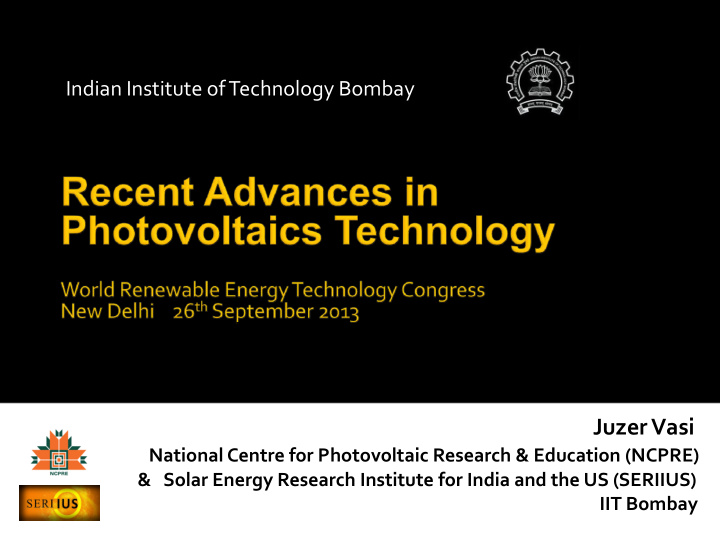



Indian Institute of Technology Bombay Juzer Vasi National Centre for Photovoltaic Research & Education (NCPRE) & Solar Energy Research Institute for India and the US (SERIIUS) IIT Bombay
� Overview of NCPRE and SERIIUS � Photovoltaics Technologies � Research in Silicon Technologies � Conventional mono / multi Si � Aluminium Oxide Passivation � Silver replacement � Sawing � Non ‐ conventional Silicon � Thin Film crystalline silicon � Si nanocrystal tandem junction � Si nanowire � Research in other Materials � Earth ‐ abundant materials – CZTS � Perovskites � Flexible Glass Substrates � Conclusions
� NCPRE set up at IIT Bombay in October 2010 � 5 year Project funded by MNRE � Multidisciplinary – 50 faculty investigators from 13 Depts � Strong Education + Research thrust NCPRE Characterization, Research Education Modeling & Simulation www.ncpre.iitb.in Solar PV New Systems & Materials & Si Solar Cells Modules Devices
� SERIIUS set up October 2012 � Leading universities, research laboratories and industries from India and USA � 5 year project funded by DST (India) and DOE (USA) www.seriius.org
Our Team:
http://www.i-micronews.com/
� Silicon (mono/multi) is the most mature technology � It has seen steep fall in prices in recent years � Can the prices decrease further? ITRPV 2012
� AlO x for p ‐ Si surface passivation � Negative charge repels electrons, good interface � By ALD (slow process) or DC sputtering (at IITB) Anil and Meenakshi, IITB Meenakshi et al., IEEE E JPV, 2013 Meenakshi et al., IEEE PVSC, 2013
� Copper much cheaper than silver � Problems � Copper is a lifetime killer; it oxidizes – extra protection layers � More complex processing Silver per cell (g/cell) ITRPV 2012
� Improved wafer slicing techniques can give thinner wafers, higher throughput, lower kerf loss � Diamond wire sawing, Wire ‐ EDM Throughput for diamond wire sawing ITRPV 2012 and slurry based sawing
� Wire Electrical Discharge Machining (WEDM) � Low kerf loss; 100 micron wafers possible Upper wire guide Dongre & Clamp Silicon ingot Joshi, IITB (75 mm square) Brass wire (Diameter: 100 µm) Lower wire guide Machine table
� 20.1% Thin Film crystalline Si solar cells on flex substrates � Solexel’s patented process � Reusable silicon wafer Solexel www.solexel.com
Wires by etching Deposition of 500 nm diameter PS beads was done by spin coating Size of beads was reduced by O 2 plasma Si etched by using DRIE chemistries of C 4 F 8 and SF 6 Residual PS beads removed using Toluene solution N ‐ poly is deposited on Si Nano Wires ITO deposition is done using metal Sputter System
O 2 ashing of beads Dispersal of beads Deep reactive ion etching of nanowires ITO deposition N-polySi deposition Anil Kottantharayil, IIT Bombay, unpublished
J SC = 16.4 mA/cm 2 , V OC = 2282 mV, FF = 84.3 %, η = 31.6% . Ga 0.35 In 0.65 P 1.67 eV Ga 0.83 In 0.17 As 1.18 eV Ge 0.66 eV W. Guter et al., Applied Physics Letters , vol. 94, no. 22, p. 223504, 2009.
Si Nanocrystals (Quantum Dots) in a SiO 2 matrix. Varying the size of the QDs changes their bandgap. All-Si 3-cell Multijunction Tandem Solar Cell E.C. Cho et al., Advances in Opto Electronics , vol. 2007, pp. 1-11, 2007. M . Green, MRS Spring Symposium , San Francisco, 2006
Mavilla Narasimha Rao, IIT Bombay
� “Earth ‐ abundant” materials � 11% cells achieved at IBM Schematic of CZTS solar cell (inset) and SEM J-V Characteristics of solution processed of solution processed CZTS cell (Mitzi et al., CZTSSe cells of Mitzi et al. (IBM) with varying IBM) S and Se composition ratio Mitzi et al. Adv. Mater. 2010, 22, E156–E159
Perovskite sensitized solar cell 0.0 0.2 0.4 0.6 0.8 1.0 16 16 (it replaces the dye in DSSC) 2 ) 14 14 Current Density (mA/cm Gratzel (HOPV 2013) � 14.1% 12 12 10 10 8 8 Mixed Halide Organometal Perovskites 6 6 CH 3 NH 3 PbI 2 X perovskites (X = Cl, Br, I) 4 4 2 2 0 0 0.0 0.2 0.4 0.6 0.8 1.0 Voltage(V) 5% perovskite sensitized solar cell at IIT Bombay (Sarkar)
Planar configuration of Vapour deposited and spin coated p-i-n cell configuration “Efficient planar heterojunction perovskite solar cells by vapour deposition” by Current-density/voltage curves of the M. Liu, M. B. Johnston & H. J. Snaith best-performing solution-processed and Nature (2013) doi:10.1038/nature12509 vapour-deposited planar heterojunction Received:19 June 2013 Accepted: 25 July 2013 perovskite solar cell Published online 11 September 2013 “over 15%” efficiency
� 100 micron thick flexible glass substrates from Corning � Processing temperatures of ~ 500 C possible � Roll ‐ to ‐ roll processing � Ideal for ink ‐ based processing
August 2013 gust 2013 Source: NREL
� New developments in photovoltaic technologies � Research continues for silicon as well as new materials; new processing � Some exciting developments recently � Thin Film Crystalline Si � Perovskite based solar cells � Research on many of these going on at IIT Bombay through NCPRE and SERIIUS
Recommend
More recommend